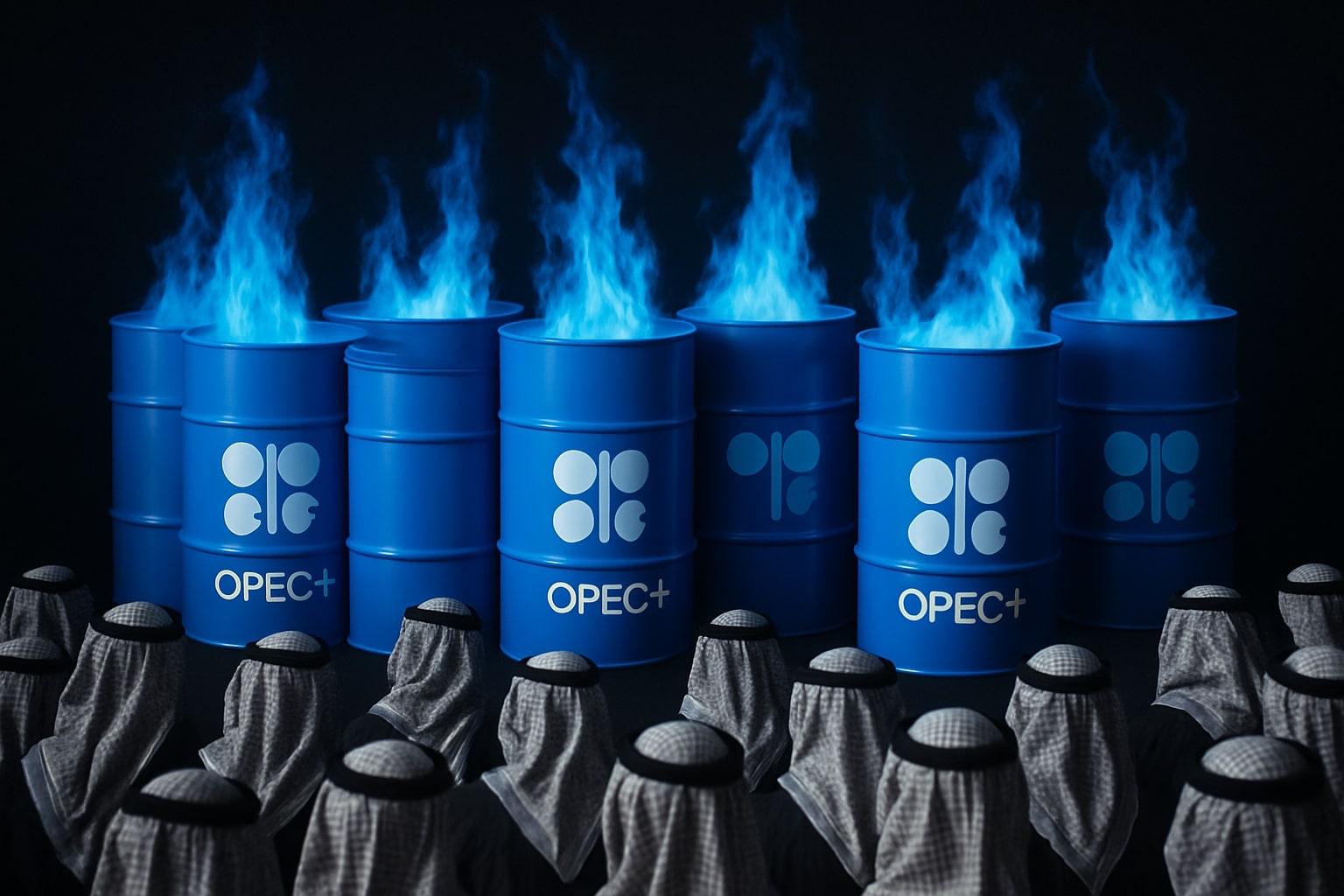
Oil Prices Forecast - Oil Jump as 2.2M-Barrel Russian Disruption Collides With Global Oversupply
WTI pushes back to $60 and Brent climbs above $64 after the Novorossiysk attack, while shadow fleets swell to 70 million barrels | That's TradingNEWS
WTI CL=F And Brent BZ=F Oil Price Outlook Amid Expanding Supply Shocks, Floating Storage Surge, And Geopolitical Escalation
Oil is trading on a knife-edge as WTI (CL=F) rebounds toward $60.00 and Brent (BZ=F) lifts back above $64.00, driven by simultaneous structural oversupply signals and violent geopolitical disruptions that continue to reshape the flow of global barrels. The price action is no longer moving on a single driver; instead, it reacts to a collision of factors: a historic jump in floating storage, Iranian heavy crude sitting at 36 million barrels, Russia losing up to 1.1 million bpd of refining capacity, Ukrainian missile strikes halting 2.2 million bpd through Novorossiysk, OPEC shifting from deficit to a 500,000 bpd surplus, and the IEA projecting a 4 million bpd surplus in 2026. Oil is now defined by imbalance—too much supply on the ocean, but too many risks on land.
WTI CL=F Price Behavior Reflecting The Clash Between Excess Barrels And Violent Supply Disruptions
WTI’s surge to $60.09, a +2.39% daily jump, highlights how quickly geopolitical risk is overpowering the bearish macro picture. The direct strike on Russia’s Novorossiysk export hub froze 2.2 million bpd, roughly 2% of global supply. The impact is immediate because Novorossiysk exported 3.22 million tons (about 761,000 bpd) in October alone and shipped 24.7 million tons in the first ten months. Two berths—handling tankers of 40,000 DWT and 140,000 DWT—were hit, and the Sierra Leone–flagged tanker Arlan was damaged. This shock came days after Ukraine destroyed segments of Russia’s refining network, eliminating up to 20% of refining capacity, equal to 1.1 million bpd of processing. When you pull that much offline, even temporarily, it forces markets to reprice geopolitical risk immediately, and WTI’s rebound reflects traders recognizing that supply may not be as “loose” as OPEC and the IEA insist.
Brent BZ=F Balances Between OPEC’s Softening Tone And A Shadow Market Overflowing With Sanctioned Crude
Brent’s lift to $64.39 (+2.19%) follows the same logic but is pressured heavily by the surge in shadow barrels across Asia. Floating storage has exploded: 53 million barrels in Asia, including 20 million barrels added in just two months, according to Kpler. OilX’s higher estimate—70 million barrels—shows unsold crude rising even faster. Iranian crude at sea hit 161 million barrels, up 22.5 million from September; Venezuelan flows reached 72.3 million barrels. This tonnage matters because if even a fraction hits refiners, Brent risks slipping sharply—the very opposite of what its short-term rally implies. OPEC’s own data reinforces that risk. It now sees Q3 swinging into a 500,000 bpd surplus, a full reversal from the previous 400,000 bpd deficit projection. Brent’s price is climbing because of panic, not structural tightness.
Heavy Crude And OPEC Basket Signals Indicate A Market Leaving The High-Price Era Behind
The easing of heavy crude benchmarks confirms how different today’s market is compared to 2022–2023. Iran’s heavy crude averaged $70.7 across the first ten months of 2025, down from $81 in 2024. The OPEC basket settled at $70.8, far from the $102 peak during the Russia–Ukraine breakout. Brent’s weakening to around $70.1 earlier in the year shows global refineries shifting back into a normalization phase. The main reason is purely structural: OPEC increased output, U.S. production hit a record 13.862 million bpd, and the IEA confirmed global supply swelling 6.2 million bpd since January. Even with October output declining 440,000 bpd, supply remains too strong. Oil on water jumped 80 million barrels in September alone. Markets are digesting this tonnage slowly, which depresses heavy crude relative to lighter grades and aligns with falling global industrial momentum.
Russian Crude Exports Under Siege As Ukraine’s Offensive Reshapes Physical Oil Flows
The Ukrainian campaign is no longer symbolic—it is reshaping trade balances. Ukraine has targeted at least 28 Russian refineries in three months, slashing export capability. Russia’s seaborne fuel shipments fell to 3.45 million bpd, down 130,000 bpd week-over-week. Key pipelines feeding Novorossiysk halted flows after the attack. With China cancelling some Russian cargoes and shifting toward Middle Eastern and U.S. blends, Russian oil faces both logistical and buyer-related bottlenecks. The global market lives on Russian supply consistency; disruptions of 700,000 bpd from Novorossiysk and 1.1 million bpd lost through damaged refining units directly rattle risk pricing. Even so, if sanctions-hit barrels eventually reach buyers through shadow tracking routes, they will amplify oversupply pressure—reinforcing the bearish case. This push-pull tension defines the current WTI and Brent structure.
OPEC+ Strategy Turns Defensive As Saudi Arabia Cuts Prices And A 2026 Glut Emerges
Saudi Arabia’s decision to lower crude prices for Asia to an 11-month low reveals how aggressively Riyadh is working to stay competitive amid oversupply. OPEC+’s November 2 decision to raise output 137,000 bpd in December before freezing hikes in Q1 2026 confirms the group sees a fragile balance. The IEA’s projected 4 million bpd surplus in 2026 is the most bearish outlook in three years. Even OPEC’s October production—29.07 million bpd, a 2.5-year high—adds to the weight. Meanwhile Vortexa’s latest reading shows floating storage at 95.18 million barrels, rising 11% in a week. These are not signs of a tight market. These are signs of a system that is producing too much crude with not enough physical demand to absorb it.
Chinese Import Growth And U.S. Output Records Add Layers To The Supply Side
China remains the single largest stabilizer for oil prices. Jan–Oct crude imports grew 3.1%, hitting 471 million metric tons, showing that Asian refiners continue to act as the world’s swing absorbers. But that demand is now clashing with high inventories and import quota limits in Shandong. U.S. output at 13.862 million bpd is the highest ever recorded, with crude and distillate inventories sitting 4.1% and 7.9% below seasonal averages. The inventory deficit suggests strong demand, but the problem is pace: U.S. supply is growing faster than drawdowns. That imbalance keeps pressure on global benchmarks, even when geopolitical shocks lift short-term prices.
Read More
-
Nebius Stock Price Forecast - NBIS Shares Collapses to $83.54 While Securing $20B+ AI Megadeals
16.11.2025 · TradingNEWS ArchiveStocks
-
XRP Price Forecast - XRP-USD Stalls at $2.22 Despite $58M XRP ETF Surge
16.11.2025 · TradingNEWS ArchiveCrypto
-
Gold Price Forecast - Gold Reverses at $4,133 as XAU/USD Falls to $4,085
16.11.2025 · TradingNEWS ArchiveCommodities
-
Stock Market Today: Wall Street Drops as Nasdaq Hits 22,552 and S&P Falls to 6,664 Before Nvidia’s Report
16.11.2025 · TradingNEWS ArchiveMarkets
-
GBP/USD Price Forecast - Pound Drops to 1.31743 as Fiscal Turmoil and Delayed US Data Shake Markets
16.11.2025 · TradingNEWS ArchiveForex
Geopolitical Risk Premium Re-Emerges As Middle East Tensions Escalate And Sanctions Spread
The Iranian seizure of an oil tanker in the Gulf of Oman is another risk catalyst. Iran’s retaliation cycle raises concerns across Hormuz—the choke point for 20% of global crude flows. Combined with U.S. threats of military action against Venezuela, traders must price in the possibility of additional disruptions across multiple regions. Supply risk is rising across Russia, the Middle East, and Venezuela simultaneously, which is why prices bounced even in the face of bearish supply data. Risk premium can move WTI by $4–$10 in a matter of hours if escalation continues.
WTI And Brent Verdict: The Market Is Fundamentally Bearish But Temporarily Supported By Violence And Chaos
The combined data paints a clear, fact-driven picture. Oversupply is the dominant structural force—OPEC sees a surplus, the IEA sees a 4 million bpd glut coming, Russia’s floating crude piles up, Iran struggles with 36 million barrels stuck at sea, and U.S. output breaks records. At the same time, geopolitical shocks are the only reason oil is not collapsing below $55 WTI and $60 Brent. The clash between excessive supply and sudden export disruptions creates a volatile but asymmetric setup.
Verdict: Oil is a SELL on structural fundamentals but a SHORT-TERM HOLD due to high geopolitical risk.
If Russia stabilizes its export channels, if Iranian floating crude finds buyers, or if Ukraine’s strikes slow down, both WTI and Brent likely retest $55 and $58 respectively. If geopolitical escalation deepens—especially at Novorossiysk or Hormuz—WTI can reclaim $63–$65, and Brent can test $68–$70.



















